Study the Antioxidant and Anti Bacterial Activity of Fruits, Peels and Juice of Punica granatum L

Published
Oct 6, 2025Pages
35-46Abstract
Pomegranate (Punica granatum L.) fruit is being cultivated since the civilization is known, and its production and consumption have been increased since the last century due to the scientific confirmation of its health benefits. Pomegranate fruits, juice, its seeds, and peels are known to have higher contents of bioactive compounds, viz., phenolic acids, flavonoids, and hydrolysable tannins. Capacity to scavenge free radicals for each of the five extracts (hot alcoholic, hot water, cold alcoholic, cold water, and juice extract). At 400 μg/mL, the highest percentage of scavenging activity was found in hot alcoholic extract (77.97, 69.43, 51.54, 46.12, and 44.21%), respectively. The antimicrobial activity was evaluated by agar diffusion method. All concentrations of Punica granatum extracts had antibacterial activity against Bacillus subtitles, Staphylococcus aureus, Staphylococcus epidemics, Escherichia coli, Klebsiella spp., and Pseudomonas aeruginosa. the highest antibacterial activity of Peel Hot alcoholic extract at concentration 200 µg/ml was the highest effective against bacteria under study inhibition zone was ( 28, 22, 32,16 mm).
References
- Jazani, N. H. Shahabi, S. Ali, A. A. Zarrin S and Daie N A (2007). " In Vitro Antibacterial Activity of Garlic Against Isolate of Acinetobacter Sp". Journal of Biological Science, 7(5),p. 819-822.
- Kumar, A. Dora, J., Kumar , A. and Kumar, A. (2012). " Pomegranate (Punica granatum)-Overview". International Journal of Pharmaceutical and Chemical Science, 1(4), p. 1218-1222.
- Kuok, C. S, Hoi, C. Chan, I. Fong, C., Meng, N. L. and Fong P (2017) "Synergistic Antibacterial Effects of Herbal-Extracts and Antibiotics on Methicillin-Resistant Staphylococcus aureus: A Computational and Experimental Study". Experimental Biology and Medicine, 242, p. 731–743.
- Lee, C., Lee, J. H., Park, M. Park, K. S. Bae, K. Kim, Y. B. Cha, C. Jeong, B.C. and Lee, S.H.( 2017). " Biology of Acinetobacter baumannii: pathogenesis, Treatment Options. Frontier" Cellular and Infection Microbiology,7,(55), p. 1-35.
- Hussain, M.S. Fareed, S. Ansari, S. Rahman, M.A. Ahmad, I.Z. Saeed, M.( 2012 ) "Current approaches toward production of secondary plant metabolites", J. Pharm. Bioallied Sci., 4, p. 10–20.
- Gupta, P.D. Birdi, T.J. ( 2017). " Development of botanicals to combat antibiotic resistance",J. Ayurveda Integr. Med., 8, p. 266–275.
- Rummun, N. Somanah, J. Ramsaha, S.; Bahorun, T. Neergheen-Bhujun, V.S.( 2013). "Bioactivity of Nonedible Parts of Punica granatum L.:
- Potential Source of Functional Ingredients", Int. J. Food Sci. 6, (2) p.312.
- Aviram, M. Dornfeld, L. Rosenblat, M. Volkova, N. Kaplan, M. Coleman, R.; Hayek, T. Presser, D. Fuhrman,( 2000) . "Chemopreventive and adjuvant therapeutic potential of pomegranate (Punica granatum) for human breast cancer". Breast Cancer Research and Treatment ,71, p. 203–217,
- Jurenka, J.S. (2008). "Therapeutic applications of pomegranate (Punica granatum L.) ": A review. Altern. Med. Rev., 13, p. 128–144.
- Grady L.; Sigge G., Caleb, J. Opara, L. ( 2014) . " Bioactive compounds and quality attributes of pomegranate arils(Punica granatum L.) processed after long-term storage". Food Package, 2, p. 30–37.
- Adiga, S. Tomar, P. Rajput, R.R.( 2010). "Effect of Punica Granatum Peel Aqueous Extract on Normal and Dexamethasone Suppressed Wound Healing in Wistar Rats". Int. J. Pharm. Sci, Rev. Res., 5, p. 34–37.
- Guerrero-Solano, J.A. Jaramillo-Morales, O.A. Velázquez, C. De La O-Arciniega, M. Castañeda-Ovando, A. Betanzos-Cabrera, G. Bautista, M.( 2020 ). " Pomegranate as a Potential Alternative of Pain Management": A Review. Plants, 9, p. 419.
- Al-Zoreky, N.(2009). "Antimicrobial activity of pomegranate (Punica granatum L.) fruit peels". Int. J. Food Microbiol, 134, p. 244–248.
- Dahham, S. Ali, M.N. Tabassum, H. Khan, M.( 2010). Studies on Antibacterial and Antifungal Activity of Pomegranate(Punica granatum L.). Am. Eurasian J. Agric. Environ. Sci., 9, p. 273–281.
- Ferrazzano, G.F.; Scioscia, E.; Sateriale, D.; Pastore, G.; Colicchio, R.; Pagliuca, C.; Cantile, T.; Alcidi, B.; Coda, M.; Ingenito, ( 2017). " In Vitro Antibacterial Activity of Pomegranate Juice and Peel Extracts on Cariogenic Bacteria". BioMed Res. Int., 21, (5) p. 27-49.
- Malviya, S. Jha, A.( 2014). "Hettiarachchy, N. Antioxidant and antibacterial potential of pomegranate peel extracts". J. Food Sci. Technol.,51,p. 4132–4137.
- Elshafie, H. Caputo, L. De Ma.tino, L. Sakr, S. De Feo, V. Camele, I. (2021). " Study of Bio-Pharmaceutical and Antimicrobial Properties of Pomegranate (Punica granatum L.) Leathery Exocarp Extract". Plants, 10, p. 153.
- Tanveer, A.; Farooq, U.; Akram, K.; Hayat, Z.; Shafi, A.; Nazar, H.; Ahmad, Z.( 2014). "Pomegranate Extracts: A Natural Preventive Measure against Spoilage and Pathogenic Microorganisms". Food Rev. Int. 31,p. 29–51.
- Bialonska, D. Kasimsetty, S.G. Schrader, K.K. Ferreira, D. (2009). " The Effect of Pomegranate (Punica granatum L.) Byproducts and Ellagitannins on the Growth of Human Gut Bacteria". J. Agric. Food Chem., 57, P. 8344–8349.
- Fischer, U.A. Carle, R. Kammerer, D.R.( 2011 ). " Identification and quantification of phenolic compounds from pomegranate(Punica granatum L.) peel, mesocarp, aril and differently produced juices by HPLC-DAD–ESI/MSn". Food Chem., 127,P. 807–821.
- Gil, M.I. Tomás-Barberán, F.A. Hess-Pierce, B. Holcroft, D.M. Kader, A.A.( 2000). "Antioxidant Activity of Pomegranate Juice and Its Relationship with Phenolic Composition and Processing". J. Agric. Food Chem. 48,p. 4581–4589.
- Reddy, M.K. Gupta, S.K. Jacob, M.R. Khan, S.I. Ferreira, D. (2007). "Antioxidant, Antimalarial and Antimicrobial Activities of Tannin- Rich Fractions, Ellagitannins and Phenolic Acids from Punica granatum L". Planta Med. 73, p. 461–467.
- Gosset-Erard, C. Zhao, M. Lordel-Madeleine, S. Ennahar, S.
- ( 2021). "Identification of punicalagin as the bioactive compound behind the antimicrobial activity of pomegranate (Punica granatum L.) peels". Food Chem. 352, p. 12, p. 93-96.
- Singh, B. Singh, J.P. Kaur, A. Singh, N. ( 2018). "Antimic,robial potential of pomegranate peel": A review. Int. J. Food Sci. Technol. 54, p. 959–965.
- Robinson, P.K.( 2015). "Enzymes: Principles and biotechnological applications". Essays Biochem. 59, p.1–41.
Identifiers
Download this PDF file
Statistics
Copyright and Licensing

This work is licensed under a Creative Commons Attribution-NonCommercial 4.0 International License.